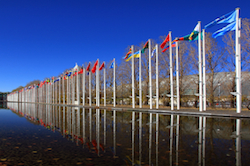
In part 1 of a 5 part series on Water Diplomacy, Program on Negotiation faculty member Lawrence Susskind and his colleague Shafiqul Islam present their research with regard to water diplomacy in the Middle East.
By Lawrence Susskind, Shafiqul Islam
Most difficulties in water negotiations are due to rigid assumptions about how water must be allocated. When countries (or states) share boundary waters, the presumption is that there is a fixed amount of water to divide among them, often in the face of ever-increasing demand and uncertain variability. Such assumptions lead to a zero-sum mindset, with absolute winners and losers. However, when parties instead understand that water is a flexible resource and use processes and mechanisms to focus on building and enhancing trust, even countries in conflict can reach agreements that satisfy their citizens’ water needs and their national interests.
The Israel-Jordan Treaty of Peace serves as an excellent example of how value can be created and trust can be enhanced. It also demonstrates how innovative technologies and a collaborative administration can not only facilitate problem solving but also introduce important means for enhancing sustainable solutions that are acceptable to all sides.
Israel and Jordan: From War to Water Sharing
The two largest streams in the Jordan River basin, the Jordan River and the Yarmouk River (and the significant groundwater sources associated with them), are both shared by Jordan and Israel. This situation posed serious challenges to the two countries as they attempted to manage what they viewed as “their” water.
From 1948 until 1994, the countries unilaterally tried to manage the available water to meet their development needs. Negotiations regarding how much each side should extract have failed. As a result, both countries overdrew the water that was available, critically damaging the environment and their own long-term water security.
In 1994, Israel and Jordan signed a peace treaty that included a detailed agreement regarding water sharing and seasonal transfers across borders, but within the basin. Although the agreement was bilateral and the three other riparian enemies – Syria, Lebanon, and the Palestinian territories – were not included, given the political dynamics, it was a remarkable accomplishment.
Technological and scientific creativity facilitated the section of the treaty dealing with water (Annex II). The treaty specifies that Israel may extract twelve million cubic meters (MCM) of water during the summer and thirteen MCM in the winter from the Yarmouk River.
Strategic Ambiguity
In exchange, Jordan is allowed to “store” twenty MCM of its water in Lake Tiberias in Israel during the winter. Israel agreed to help Jordan find additional water using desalination technology. This dovetailed nicely with Israel’s long-term desalination program. (In fact, in its recently released National Water Plan, Israel stated that it intends to meet 70 percent of its water needs through desalination by 2040).
Because the negotiators realized the importance of acknowledging ambiguity and the different types of uncertainties, discussed in future posts, they created a Joint Water Committee with three individuals appointed by each government to oversee implementation and address future challenges. According to Italy Fischhendler, this also allowed them to leave certain politically sensitive issues for a later date, avoiding backlash from domestic constituents and creating an agreement characterized in party by “strategic ambiguity.”
This cooperative approach – involving joint fact-finding and monitoring – appears to be the key to the longevity of the agreement. Even in the face of drought and water shortages, and while political conflicts and uncertainties continue to smolder, water professionals have kept working together through the Joint Committee. With this important trust-building component of the agreement, the parties have been able to return to some of the issues that were uncertain or too politically sensitive to deal with when the treaty was first signed.
Building relationships between governments, however, is not enough.
There is an important role for “non-state” actors, such as water users, nongovernmental organizations (NGOs), and networks of scientists and universities, to play in treaty implementation that can add an important dimension to trust-building efforts. As we explored in our recent book, stakeholder networks are important to the success of adaptive management.
They can provide on-the-ground feedback, especially as governments experiment with new technologies or ways of managing water supply and pricing. Often these civil society groups have detailed knowledge of what is actually happening as opposed to what was intended. In addition, their strong interest in promoting better outcomes can push governments to keep searching for “joint-gain” solutions. In the Jordan River basin, nongovernmental organizations (NGOs), such as the Friends of the Earth Middle East, convened experts and advocates from both sides that were very helpful to the negotiators.
In our FREE special report from the Program on Negotiation at Harvard Law School – The New Conflict Management: Effective Conflict Resolution Strategies to Avoid Litigation – renowned negotiation experts uncover unconventional approaches to conflict management that can turn adversaries into partners.
Part 2: Uncertainty, Risk, and Opportunity



